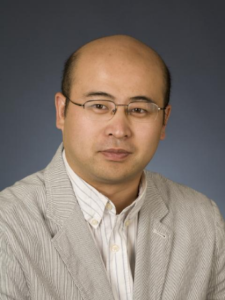Electric Propulsion for Future Aero and Space Vehicles
Session A & B
Organizer: Jin Wang
Abstract:
For better fuel economy and carbon oxide reduction, future aircrafts calls for electric propulsion. Though there have been significant developments in electric machines and power electronics in the last few decades, electric propulsion presents significant challenges and opportunities.
At the system level, the high power rating of the electric propulsion calls for higher distribution voltage. Currently, the distribution voltage for more electric aircrafts is limited to 540 V because of partial discharge related issues. In the future, where a single aisle commercial aircraft will require more than 10 Megawatt of propulsion power, the electric power distribution voltage is expected to reach as high as 4 kV, which presents a significant challenge in the system architecture and insulation designs.
At the sub-system level, to realize high fuel economy, electric machines and power electronics drives are expected to have ultra-high power densities of 14 kW/kg and 25 kW/kg, respectively, which requires significant innovations in material, device, machine structure, power electronic packaging, control and thermal management.
For future space explorations, there are also significant challenges on power conversion systems in terms of weight and volume power density, device radiation hardness, light weigh insulation material, harsh operation environment, power distribution and protection, etc. Some of the challenges are similar to the ones faced by aero vehicles and solutions can possibly apply to both type of applications.
This special session has invited speakers from NASA, US Air Force, industry and academia to present challenges and solutions for electric propulsion for future aero and space vehicles.
Short Bio of Organizer:
 Jin Wang received a B.S. degree from Xi’an Jiaotong University, in 1998, an M.S. degree from Wuhan University, in 2001, and a Ph.D. from Michigan State University, East Lansing, in 2005, all in electrical engineering. From Sept., 2005 to Aug. 2007, he worked at the Ford Motor Company as a Core Power Electronics Engineer. He joined the Ohio State University in 2007 as an Assistant Professor and was promoted to Associate professor in 2013 and full professor in 2017. His research interests include wide bandgap power devices and their applications, high-voltage and high-power converter/inverters, integration of renewable energy sources, and electrification of transportation. Dr. Wang has over 190 peer-reviewed journal and conference publications and 9 patents.
Jin Wang received a B.S. degree from Xi’an Jiaotong University, in 1998, an M.S. degree from Wuhan University, in 2001, and a Ph.D. from Michigan State University, East Lansing, in 2005, all in electrical engineering. From Sept., 2005 to Aug. 2007, he worked at the Ford Motor Company as a Core Power Electronics Engineer. He joined the Ohio State University in 2007 as an Assistant Professor and was promoted to Associate professor in 2013 and full professor in 2017. His research interests include wide bandgap power devices and their applications, high-voltage and high-power converter/inverters, integration of renewable energy sources, and electrification of transportation. Dr. Wang has over 190 peer-reviewed journal and conference publications and 9 patents.
Dr. Wang received the IEEE Power Electronics Society Richard M. Bass Young Engineer Award in 2011, the National Science Foundation’s CAREER Award in 2011, and the Nagamori Award in 2020. At The Ohio State University, Dr. Wang received the Ralph L. Boyer Award for Excellence in Undergraduate Teaching Innovation in 2012, the Lumley Research Award in 2013 and the Harrison Faculty Award for Excellence in Engineering Education in 2017. Dr. Wang served as the General Chair and the Steering Committee Chair for the IEEE Future Energy Challenge in 2016 and 2017, respectively. Dr. Wang had been an Associate Editor for the IEEE Transactions on Industry Applications from 2008 to 2014. Dr. Wang has served in many leading conference organization committees. Dr. Wang initiated and served as the General Chair for the 1st IEEE Workshop on Wide Bandgap Power Devices and Applications in 2013. Currently, Dr. Wang serves as the Tutorial Co-chair for IEEE Applied Power Electronics Conference 2020, an Associate Editor for the IEEE Transactions on Power Electronics and the IEEE Journal of Emerging and Selected Topics in Power Electronics (J-ESTPE).
Speakers and presentations:
- Raymond F. Beach, Principal Technologist for Power & Energy Storage, NASA Glenn Research Center
Space Power Technology Challenges and Needs to Support Lunar/Mars Campaign
- Thomas M. Jahns, Professor, University of Wisconsin
How Do We Make Electrified Aircraft Propulsion Systems Safe to Fly?
- Xin Wu, Principal Scientist at UTRC
Challenges and Opportunities for Electric Drive Train in Electrified Aircraft Propulsion Systems
- Longya Xu, Professor, The Ohio State University
Doubly Fed Brushless Machine for High Speed Variable Systems
- Pat Wheeler, Professor, University of Nottingham
Electric Aircraft Propulsion System – Scaling-up to Meet Future Aircraft Roadmaps
- Daniel L. Schweickart, Air Force Research Laboratory/Aerospace Systems Directorate
Considerations for Failure Prevention in Aerospace Electrical Power Systems Utilizing Higher Voltages
- Julia Zhang, Assistant Professor, The Ohio State University
State-of-the-art and Emerging Electric Drive Architectures for More-Electric-Aircraft Propulsion
- Parag Kshirsagar, Associate Director, Collins Aerospace Program Office, Raytheon Technologies Research Center
20 MW Electrified Aircraft